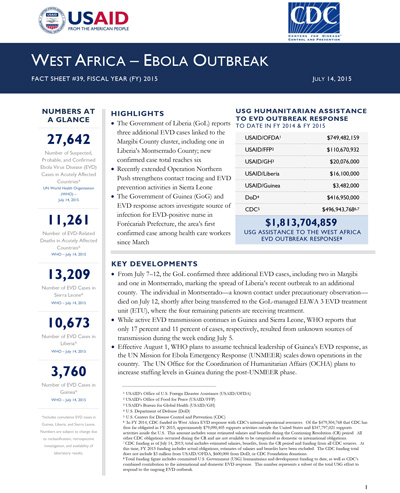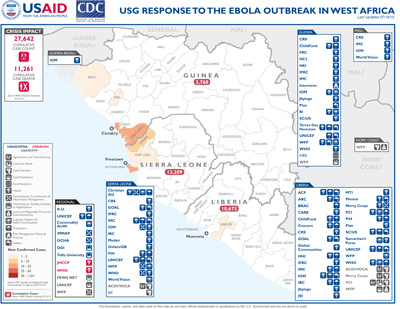Speeches Shim
July 28, 2015
HIGHLIGHTS
Ebola Response
Visit our main West Africa Ebola Outbreak page to learn more about how we're responding to the West Africa Ebola outbreak, and what you can do to help.
- Overall EVD transmission decreases in Guinea and Sierra Leone since mid-July, according to local health officials
- The GoL discharges remaining two EVD survivors from ELWA 3 ETU; Liberia currently has no confirmed EVD cases
- All known contacts in Boké Prefecture, Guinea, graduate from contact tracing on July 23
West Africa - Ebola Outbreak Fact Sheet #41 (FY 15) ![]() (pdf - 403k)
(pdf - 403k)
KEY DEVELOPMENTS
- The Government of Guinea (GoG) reported four confirmed cases of the Ebola Virus Disease (EVD) during the week ending on July 26, marking the lowest weekly caseload in the country since July 2014. Authorities have recorded recent transmission, however, in four Guinean prefectures—Conakry, Coyah, Forécariah, and Fria—and two prefectures, Dubréka and Kindia, remain on alert.
- Sierra Leone’s Kambia and Port Loko districts have not reported new confirmed cases of EVD since July 10 and 17, respectively, according to the Government of Sierra Leone (GoSL). Through Operation Northern Push, the GoSL has enforced stringent response measures in the EVD-affected districts since mid-June.
- The Government of Liberia (GoL), with support from CDC, continues to track contacts from the recent cluster of six cases from Margibi and Montserrado counties. The GoL graduated 90 contacts from July 19–25 and continues to follow 33 other contacts.
REGIONAL
In its most recent situation report covering the period from July 13–19, the UN World Health Organization (WHO) reported 26 confirmed cases of EVD in West Africa, including 22 cases in Guinea and four cases in Sierra Leone. For the second consecutive week, the majority of new EVD cases originated in the capital cities of Guinea and Sierra Leone, while transmission has ceased in recent hotspots such as Guinea’s Boké and Sierra Leone’s Kambia.
Between July 13 and 19, only two of the 26 newly confirmed cases originated from unknown sources of infection; all other EVD-positive cases were found among known contacts. Three of the cases—including two from Guinea and one from Sierra Leone—were health care workers. As of July 22, the governments of Guinea, Liberia, and Sierra Leone had reported a total of nearly 880 confirmed infections among health care workers.
West Africa Ebola Map #41 July 28, 2015 ![]() (pdf - 532k)
(pdf - 532k)
Through more than $6.4 million in assistance, USAID/FFP is supporting UNICEF’s efforts to prevent and treat severe and moderate acute malnutrition among EVD-affected children in Guinea, Liberia, and Sierra Leone. UNICEF will conduct screenings, referral, and treatment of severe acute malnutrition (SAM) and moderate acute malnutrition (MAM) among children in communities throughout the three EVD-affected countries. In addition, the UN agency plans to treat approximately 50,000 children younger than five years of age affected by SAM and MAM with ready-to-use therapeutic and supplementary food and nutritional supplements.
Liberia
The GoL continued to report no new confirmed EVD cases from July 20–27, maintaining the recent cluster's six-case total, which included five cases from Margibi and one from Montserrado. Of the six cases, two patients have died and four were discharged as survivors from Montserrado’s ELWA 3 EVD treatment unit (ETU) on July 20 and 23. On July 23, the county-level health team held a reintegration ceremony for the survivors in Margibi; representatives from the GoL Incident Management System (IMS), CDC, and WHO, among others, attended the event. The country currently has no known active cases of EVD, according to Liberian authorities.
The GoL continues to monitor 33 contacts of confirmed cases, including 17 contacts in Montserrado and 16 contacts in Margibi. According to WHO, all identified contacts of the recent cluster of cases should complete the 21-day active case monitoring period by August 2. With support from CDC, the GoL graduated 90 contacts in Margibi and Montserrado from July 19–25. With several high-risk contacts remaining within their active observation period, the GoL, WHO, and USG continue to support case investigation and contact tracing efforts
As of July 23, the GoL had not reported a new confirmed EVD case in Margibi in 16 days and in Montserrado in 11 days. High-level WHO officials recently commented that while impossible to prove, Liberia’s recent outbreak likely emerged out of the EVD survivor population, highlighting an ongoing risk for continuing EVD trensmission in the country.
The WHO- and CDC- supported GoL men’s health screening program continues to enroll EVD survivors at the Redemption Hospital clinic site in the capital city of Monrovia. The program, which provides male EVD survivors with semen testing and related counseling to increase their awareness of potential sexual transmission of EVD and knowledge of how to protect their sexual partners, had enrolled a total of 40 participants as of July 21. To date, nearly all enrollees have provided semen samples; the GoL, WHO, and CDC began conducting follow-up visits with participants to inform survivors of their test results on July 23. Program implementers are working to address challenges, including logistical constraints facing mobile teams and difficulty in determining survivor status for participants with absent or incomplete documentation. CDC is also providing technical assistance in support of GoL Ministry of Health efforts to refine public messaging regarding the risk of sexual transmission.
Sierra Leone
Between July 20 and 26, the GoSL confirmed three new EVD cases countrywide, including two in Western Area and one in Tonkolili District—the district’s first EVD case in at least 150 days.
As part of its continued support for Operation Northern Push, USAID/OFDA partner the UN Children’s Fund (UNICEF) intensified its social mobilization and community engagement activities in the EVD-affected areas of Port Loko, Kambia, and Western Area as of mid-July. UNICEF-led social mobilization teams—in collaboration with partners the International Federation of Red Cross and Red Crescent Societies (IFRC), Health for All Coalition, Restless Development, and Oxfam—visited more than 5,000 households, promoting EVD awareness and educating individuals on EVD response activities.
In Western Area Urban District, UNICEF has focused its social mobilization activities in the hot-spot areas of Congo Water, Goderich, and Magazine Wharf, emphasizing infection prevention and control (IPC) techniques through daily community meetings. Additionally, UNICEF is collaborating with local leaders and ward councilors to engage nearly 4,500 individuals within and nearby the district’s quarantined households in an effort to strengthen community-based surveillance and monitoring.
With USAID/OFDA support, the International Medical Corps (IMC) continues to support screening and referral units (SRUs) at five peripheral health units in Port Loko. The primary objective of the SRUs is to ensure that the PHUs adhere to proper IPC protocols—including patient screening, facility sanitation and waste management, as well as maintaining a safe separation between observation rooms, treatment rooms, and suspected case isolation areas. Between July 9 and 15, nearly 300 patients were screened at the five facilities’ SRUs; local and IMC staff report no IPC protocol breaches during the reporting period..
Guinea
Following four consecutive days with no reported EVD cases countrywide, the GoG confirmed reports of an EVD-positive case on July 26 from the Ratoma sub-prefecture of Conakry. The new EVD case―a registered contact―is receiving care at the Nongo ETU in Conakry. Cumulatively, the GoG reported four new confirmed EVD cases during the week ending July 26―the lowest weekly total since July 2014.
Previously, from July 13–21, the GoG reported 25 new confirmed EVD cases, including 15 from Conakry, seven from Forécariah, and three from Coyah. According to health officials, all but one of the 25 newly confirmed cases were among known contacts—an important measure of surveillance efficacy.
Of the 15 Conakry cases between July 12 and 21, the Ratoma sub-prefecture generated 13 cases, Matam sub-prefecture one, and Matoto sub-prefecture one, where authorities had not confirmed any EVD cases for six weeks.
In response, Guinean authorities announced plans to expand the micro-cerclage—a de facto quarantine currently targeting high-risk contacts in Matam and Ratoma—to Conakry’s newly affected area of Matoto. The micro-cerclage aims to identify suspected cases and reduce the risk of further EVD transmission through enhanced monitoring and surveillance, door-to-door hygiene promotion, the distribution of soap and other sanitation supplies, the deployment of four mobile health teams, free health and psychosocial services, and social mobilization, among other activities.
The 21-day monitoring period for all known contacts in Boké, located along Guinea’s border with Guinea-Bissau, concluded on July 23. According to a July 22 WHO report, authorities in Boké last identified an EVD-positive case in the prefecture on July 1. EVD transmission continues in Conakry, Coyah, Forécariah, and Fria, however, with Dubréka and Kindia remaining on alert.
USG Disaster Assistance Response Team (DART) staff visited the USAID/OFDA-supported Coyah ETU on July 20 to assess the status of ongoing renovations. Following a four-week closure, the Coyah ETU reopened on July 18 and received its first suspected case, which tested negative for EVD, on July 19.
According to UN World Food Program (WFP) staff, the Coyah site is fully staffed with nearly 180 personnel, including doctors, hygienists, nurses, psychosocial support staff, and social mobilization personnel. Clinical trial representatives for Favipiravir and Interferon—antiviral therapies—are also on-site, and additional space is planned for staff from the U.S. National Institutes of Health who plan to launch a Z-Mapp clinical trial at the ETU once patients begin arriving. As of June 22, the GoG and WHO reported that the ETU did not have any patients.
PUBLIC DONATION INFORMATION
- The most effective way people can assist relief efforts is by making cash contributions to humanitarian organizations that are conducting relief operations. A list of humanitarian organizations that are accepting cash donations for disaster responses around the world can be found at www.interaction.org.
- USAID encourages cash donations because they allow aid professionals to procure the exact items needed (often in the affected region); reduce the burden on scarce resources (such as transportation routes, staff time, and warehouse space); can be transferred very quickly and without transportation costs; support the economy of the disaster-stricken region; and ensure culturally, dietary, and environmentally appropriate assistance.
More information can be found at:
- The Center for International Disaster Information: www.cidi.org or +1.202.821.1999.
- Information on relief activities of the humanitarian community can be found at www.reliefweb.int.
USAID/OFDA bulletins appear on the USAID website at what-we-



Comment
Make a general inquiry or suggest an improvement.